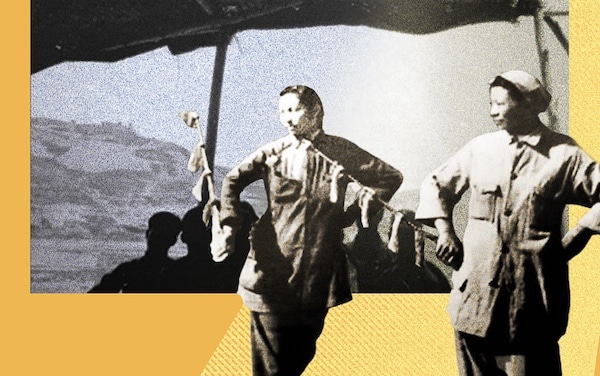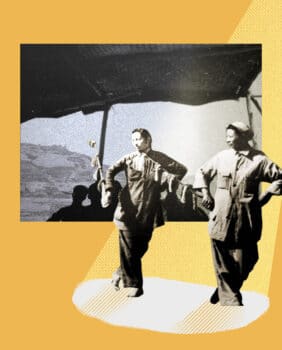The Chinese communist base area of Yan’an was a literal and metaphorical stage for envisioning, experimenting, and building a new society and a new human being. On this stage, peasants, workers, and soldiers became the actors pushing history forward and the protagonists in the stories they wrote, sung, performed in, and lived. The images of this dossier are collages using photographs of cultural and everyday life during the ‘Yan’an decade’ (1935–1945)
My heart, don’t pound so hard.Road dust, don’t block my view… I grab a handful of yellow dirt and will not let it go,Clutching it tight, close to my bosom.Many were the times I dreamt of returning to Yan’an,In dreams my arms embraced Pagoda Hill.A thousand, ten thousand times I’ve been calling you,Front: Actors of a Beijing opera troupe perform.
Back: Drama students of the Lu Xun Academy of Arts (also known as Luyi) rehearse a play in a structure they built themselves.
(Credit: Yan’an Red Cloud Platform [延安红云平台])– Mother Yan’an is here now, right here!
The Du Fu Creek Sings, and Willow Grove Village smiles,
The fluttering red flags are beckoning me.
White towels around their necks and red bands at their waist,
My dear people meet me, taking me across the Yan River.
I plunge into their arms, my arms stretched wide,
Too much to say at once, my tongue is tied.
– He Jingzhi, Return to Yan’an (1956).
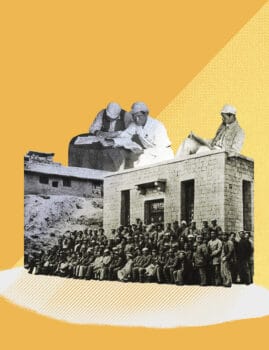
Top: Students reading at the Luyi library.
Bottom: Attendees of the 1942 Yan’an Forum on Literature and Art.
(Credit: Yan’an Literature and Art Memorial Hall [延安文艺纪念馆] and Wikimedia Commons/China Pictorial [人民画报])
Art That Serves the People
It was 1:30 in the afternoon on 2 May 1942, a cool spring day in the north-central Chinese city and communist revolutionary base of Yan’an. The central Party office, nicknamed ‘the airplane’, was housed in the city’s only three-storey building. The main hall was bustling, emptied of its usual dining furniture save for rows of benches and a single desk, ready to receive Mao Zedong when he punctually walked in. The attendees were convening for a meeting ‘to exchange views on various aspects of the current literary and artistic movement’.1 Though the precise number of participants was not recorded, over one hundred invitations had been sent days before by Kai Feng, the acting head of the Propaganda Department and chairperson of the meeting. That the invitation had been printed on pink paper, which was not locally produced, signalled the importance attached to the meeting by the top tiers of the Communist Party of China (CPC). The country’s leading intellectuals, military commanders, and political cadre gathered along with representatives from across the spectrum of art and literary work, including publishing, research, newspaper, film, photography, drama, poetry, and youth units, among others.
In the months leading up to the conference, Mao had personally exchanged dozens of letters and held several one-on-one conversations with key intellectuals, navigating the divergent artistic and literary currents of the Left and identifying the urgent cultural questions of the time. Beyond being a political leader, Mao was, after all, a poet whose own classically-informed work had documented the birth and rise of the Chinese communist movement. His poetry painted scenes of the many battles and encirclements, victories and defeats, from the communist base he helped establish in the Jinggang Mountains to the epic Long March that brought the Red Army westward. During the Yan’an period (1935–1945), he summarised these experiences in theoretical and practical writings which would come to be known as Mao Zedong Thought. There, in the cave dwellings with their iconic arches, Mao studied and wrote prolifically on topics from military tactics to philosophy, party-building to political economy, land reform to internationalism. Among these was the systematic analysis of the role of art and literature in advancing the revolutionary struggle, summarised in Talks at the Yan’an Forum on Literature and Art. In this text, published the year after the Yan’an Forum, Mao and others distilled years of experience and experimentation in communist cultural and ideological work.
Back in the Party office on that afternoon in 1942, Kai had officially opened the first of the forum’s three plenary sessions that stretched over the course of three weeks. In each of the plenaries, seated at the only desk in the room, Mao carefully took notes as points were being raised. Talks, the subsequently published text, drew from these interventions and conversations.
‘The purpose of our meeting today’, Mao said in his introductory remarks, ‘is precisely to ensure that literature and art fit well into the whole revolutionary machine as a component part, that they operate as powerful weapons for uniting and educating the people and for attacking and destroying the enemy’. To understand the enemy, Mao offered an analysis of the political conjuncture, which started ‘from objective facts…: the War of Resistance Against Japan which China has been fighting for five years; the world-wide anti-fascist war; the vacillations of China’s big landlord class and big bourgeoisie in the War of Resistance and their policy of high-handed oppression of the people’. Revolutionary conditions had emerged in China, Mao noted, because of the discontent and misery generated by a century of imperialist aggressions and the Japanese occupation; whether the political forces would be able to push back against the Chinese elite and drive an independent agenda remained to be seen. One example of the revolutionary development was the creation of the base areas and the mobilisation of popular support in these areas, including that of writers, artists, and other intellectuals. ‘In our struggle for the liberation of the Chinese people there are various fronts’, Mao said, ‘among which there are the fronts of the pen and of the gun, the cultural and the military fronts’.2
He recognised that a military victory was insufficient without creating ideological unity in the Party and placing the proletarian subjectivity at the centre of revolutionary work. The ‘army with guns’ and the ‘cultural army’ carried out complementary work: the battle in the trenches and the battle over the hearts and minds of the people. Cultural work was key to this ideological transformation, supporting workers, peasants, and soldiers in seeing themselves as the protagonists of their own stories and history.
To achieve this goal, Mao laid out five artistic and literary ‘problems’ to be addressed: position, attitude, audience, work, and study. On the first point, Mao argued that cultural workers should take a ‘class stand’–one that is firmly positioned alongside the people–in which artists also see themselves as workers in the struggle. Regarding ‘attitude’ and ‘audience’, Mao expanded on the correct approach that should be taken by artists and writers in order ‘to extol’ and ‘to expose’. In the first camp, the idea was that praise should be given to the struggles, aspirations, and ‘brightness’ of the people. On the other hand, it was also necessary to ‘expose the dark’, directing criticism towards the enemy and pointing out the shortcomings of allies in the united front to resist Japanese occupation.
In his introductory remarks, Mao highlighted some of the key debates that had emerged in Yan’an and sparked the need for the forum. He put forth a criticism of the earlier generation of the May Fourth Movement in 1919, an anti-imperialist and anti-feudal awakening led by urban intellectuals and students, many of whom were politicised in that uprising and now found themselves in Yan’an. Though they helped spark the formation of a national consciousness and a new cultural movement, their work remained largely unknown to most people and to the peasant majority. They did not speak in ‘the rich, lively language of the masses’, as Mao called it. Two decades later, the country had reached a new political conjuncture which necessitated a different kind of cultural production and a new kind of intellectual. Only through immersion and work in the countryside–both mental and physical–could these urban intellectuals transform themselves into revolutionary workers and produce artistic creations that truly served the people. This, Mao said, required ‘a change in feelings, a change from one class to another’.
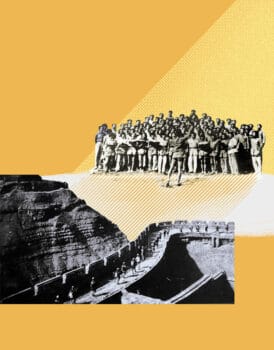
Top: A Luyi choir rehearses the Yellow River Cantata.
Bottom: Literature students travel to the battle front in northwest Shanxi.
(Credit: Yan’an Red Cloud Platform [延安红云平台])
Go to Yan’an!
‘Father, I have to leave this home, but what should I do to leave?’, wrote a sixteen-year-old woman living and studying in the southwestern Chinese city of Chengdu in the spring of 1938.3 In the letter, she expressed her dissatisfaction and desperation while confronted with the state of her homeland. Months earlier, the Second Sino-Japanese War had been triggered by an armed conflict known as the July 7th Incident on Beijing’s Luguo Bridge (or Marco Polo Bridge). The Japanese invasion and occupation of China–which began in 1931 and lasted 14 years until the end of World War II in 1945–now entered full force, taking the lives of tens of millions of Chinese people and sparking mass migration in the country.4 High schools and universities dispersed their students; some sought refuge in safer regions while others were inspired to join in the struggle for ‘national salvation’, which had become the spirit of the times. ‘So now, I have nowhere to go but Shaanbei (northern Shaanxi)’, the teenage student continued. ‘I have been considering it for a very long time, thinking of all the ways others have tried, but this is the only place that won’t let me down and will allow me to survive’.5 She was one of thousands of students and intellectuals who decided to make the long journey to the communist-held revolutionary base of Yan’an.
Situated in the Loess Plateau of the north-central province of Shaanxi, Yan’an is an important site of Chinese civilisation and people and a sacred home of the Chinese Revolution. With roots tracing back 3,000 years, Yan’an was an ancient hub home to the Yellow River, the famous yellow earth, and the mythic Yellow Emperor before populations migrated southwards.6 By the time the communists made it their capital in 1937, it was a ‘poor, dusty, and remote frontier town of about 10,000 inhabitants’.7 Yan’an was also the destination of the epic Long March (1934–1935), a mass retreat of communists from their base area in south-eastern Jiangxi after they were pushed out by a series of encirclement campaigns led by the Nationalist Party forces (Kuomintang or KMT) with the support of Nazi Germany.
Midway through the Long March, in January 1935, the Zunyi Conference was held, attended by six of the twelve members of the politburo of the CPC. The Red Army had suffered huge losses and was deeply demoralised, and this pivotal meeting established Mao Zedong as the main leader of the Party and its troops at the helm of the Chinese revolutionary process. Some 12 months, 9,000 kilometres, 18 mountains, and 24 rivers later, only 8,000 soldiers on the Long March arrived in Yan’an.8 Of the original 86,000 people who had been organised into three columns and set off on the trek, many starved, were killed, defected, or gave up along the way. It was ‘an Odyssey unequal in modern times’, as Edgar Snow called it.9 In the caves of Yan’an, Snow was the first foreign journalist to interview Mao and report to the world about the early years of the Communist Revolution, published in his classic book, Red Star Over China (1937). That year, Yan’an became the official seat of power of the CPC in the heart of the communist-controlled region known as the Shaanxi-Gansu-Ningxia Border Region. In the ‘Yan’an decade’ that followed, the ragtag group of poorly-fed and poorly-equipped communists would mobilise the support of tens of millions of peasants in the region, gain popular support in the cities, grow its active Party membership to 1.2 million people, and build a Red Army made up of one million soldiers, supported by millions more armed peasants.10 On 1 October 1949, 14 years after arriving in Yan’an, Mao Zedong would declare the establishment of the People’s Republic of China in Beijing.
As the political and cultural epicentre of the Chinese communist movement, Yan’an captured the imagination of artists, writers, and urban intellectuals from far and wide. In 1938, painter and educator Wang Shikou made the 300-kilometre journey from Xi’an to Yan’an by foot despite contracting malaria along the way. Before becoming a world-renowned cartoonist, a young Hua Junwu set off from Japanese-occupied Shanghai, passing through the southern cities of Hong Kong and Guangzhou before reaching Yan’an–all without his mother’s knowledge. That same year, prominent feminist writer of the May Fourth generation Ding Ling arrived in the communist base area. These artists and writers were among the estimated 40,000 intellectuals who would make their way to Yan’an by 1943.11 Often coming from families of landlords, aristocrats, small business owners, and rich peasants, many of these intellectuals left relative urban comforts to traverse hundreds or thousands of kilometres in wind, sand, rain, and snow.
In those exploratory early years, cultural organisations of all kinds were formed, merged, re-named, and dissolved. Artistic and literary groups were set up in factories, schools, military units, and rural bases. Street poetry groups were established, with one collective’s manifesto stating, ‘do not let a single wall in the countryside or a single rock by the side of the road lie free and empty…Write…Sing–for the resistance, for the nation, for the masses’.12 Theatre troupes, which emerged earlier in the 1930s as a powerful force in the resistance to Japanese imperialism, were particularly well received by a largely illiterate rural population. They were able to orally and accessibly communicate the most urgent problems of the day, explain the communist programme, serve as counter-propaganda, and, most importantly, win the confidence of the people. During his visit in 1936, Edgar Snow, impressed with the commitment and creativity of these troupes, called them the most ‘powerful weapon of propaganda in the communist movement’. To Snow, ‘there is no fine partition between art and propaganda. There is only a distinction between what is understandable in human experience and what is not’.13
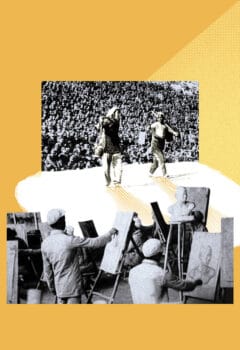
Top: A Luyi choir rehearses the Yellow River Cantata.
Bottom: Literature students travel to the battle front in northwest Shanxi.
(Credit: Yan’an Red Cloud Platform [延安红云平台](
Expose the Dark or Praise the Bright?
In the months leading up to the Yan’an Forum, five prominent writers who were all CPC members published a series of essays in the Party paper, Liberation Daily (Jiefang Ribao). Ding Ling, the paper’s editor, along with Ai Qing, Lou Feng, Wang Shiwei, and Xiao Jun, criticised the lack of access to reading materials in the base area, unconducive conditions for artistic creation, special status of CPC leaders, and subjugation of women. At the heart of the essays was the question of artistic independence and the perceived restrictions set by the Party on artistic production. Was the role of art and literature to ‘praise the bright’–to glorify the deeds of the Party and the people–or to ‘expose the dark’ and point to the problems in Chinese society and the communist movement?15
Zhou Yang, a Party leader responsible for art and cultural work and a trusted comrade of Mao, led the other side of the debate. In Remarks on Literature and Life (1941), Zhou sharply rebuts the criticisms raised:
…in these very villages lie the fresh stories of life and struggle worthy of artistic treatment. If you feel there is nothing to write about now, let your intense desire for life replace your creative urge. Stepping out from your caves and mingling a bit with the common people would certainly help.16
These back-and-forth exchanges precipitated the Yan’an Forum, where Xiao Jun, the key oppositional voice, was the first speaker invited by Mao to give comments at the initial plenary session. Over the following three weeks, the debates continued in convenings within respective artistic fields, in published articles, and in two other plenary sessions held on the 16th and 23rd of May 1942. The points raised were systematised, revised, and reflected upon. A year later, Talks at the Yan’an Forum on Literature and Art was first published on the seventh anniversary of the death of the influential writer and leading figure of the May Fourth Movement, Lu Xun.
In the published text, the conclusion is separated into five sections, starting with the central question: ‘literature and art for whom?’ Inspiration was drawn from Soviet leader Vladimir Lenin’s Party Organisation and Party Literature (1905), which identified the goal of cultural work as serving the ‘millions of working people–the flower of the country, its strength and its future’.17 Mao broadened the conception of ‘the people’ to include not only industrial workers but also peasants, soldiers, and the urban bourgeoisie, thereby situating intellectuals as workers among the masses. The second section focuses on ‘how to serve’, balancing the need to popularise revolutionary ideas with the urgency to raise the cultural standards and literacy of the people. ‘Through the creative labour of revolutionary writers and artists’, Mao wrote, ‘the raw materials found in the life of the people are shaped into the ideological form of literature and art serving the masses of the people’. In other words, revolutionary culture draws from and returns to the people, the ‘inexhaustible’ and ‘only source’.
The third section takes up the relationship between cultural work and revolutionary work as a whole. It contains one of the better-known passages of the text, which argues against the detachment of art from politics, intellectuals from the people, and culture from revolutionary work:
In the world today, all culture, all literature and art belong to definite classes and are geared to definite political lines. There is in fact no such thing as art for art’s sake, art that stands above classes, or art that is detached or independent of politics. Proletarian literature and art are part of the whole proletarian cause; they are, as Lenin said, cogs and wheels in the whole revolutionary machine.
By placing politics – particularly class politics–at the centre of cultural work, Mao firmly rejected the notion that art and culture could exist disconnected from society.
In the fourth section, Mao defined the criteria for judging artistic intention based on social practice and impact. For Mao, the study of Marxism was essential to uprooting the inherited bourgeois, feudal, liberal, and individualistic ways of seeing, so that ‘while they are being destroyed, something new can be constructed’. The final section points to the thousands of intellectuals who had arrived in Yan’an to serve the revolution, many of whom had joined the Party in body but not yet in mind. The Yan’an Forum and subsequent text were not just a response to a small group of intellectual critics: they were part of this greater ideological struggle against the ‘non-proletarian ideology’ that still existed among many Party members.
The historic forum was part of the Rectification Movement (1942–1944) that sought to create ideological unity in the Party and shrink the still-large gap between the work of the artists and writers and the reality of the peasant majority.18 The detachment of intellectuals from material circumstances has long been a problem explored in the Marxist tradition. ‘The philosophers have hitherto only interpreted the world in various ways; the point is to change it’, wrote Karl Marx in Theses on Feuerbach (1845). Half a century later, Antonio Gramsci called for the creation of a ‘new intellectual’, one who would throw themself into ‘active participation in practical life, as constructor, as organiser, “permanent persuader” and not just a simple orator’.19 Similarly, Mao believed that in order to create these ‘new intellectuals’, the traditional intellectuals like those who went to Yan’an had to struggle to transcend their class origins.
The revolutionary process required the creation of a new intelligentsia that brought in new revolutionary ideas rooted in the culture of rural China–in other words, a mass culture, a people’s culture. During the Yan’an decade, the new intellectuals partook in cultural programmes and mass literacy campaigns, combatting the 90 percent illiteracy rate in the countryside. At the time of the Yan’an Forum, Mao estimated that there were already more than 10,000 cadres in Yan’an who could read; during this process, they would unlearn and relearn how to interpret the world around them.
At the same time, the cultural power of the people had to be built. This required the ‘raising of standards’, as Mao put it in Talks: increasing the cultural literacy of the people while simultaneously awakening their revolutionary consciousness. However, the creation of a new popular culture would not happen overnight. In the early years after the Russian Revolution, Lenin reflected on a similar question regarding the building of workers’ power:
Soviet power is not a miracle-working talisman. It does not, overnight, heal all the evils of the past–illiteracy, lack of culture, the consequences of a barbarous war, the aftermath of predatory capitalism. But it does pave the way to socialism. It gives those who were formerly oppressed the chance to straighten their backs and to an ever-increasing degree to take the whole government of the country, the whole administration of the economy, the whole management of production, into their own hands.20
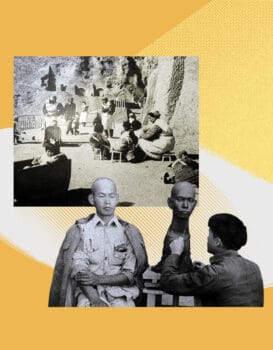
Top: Women and children at Luyi nursery.
Bottom: Professor Wang Chaowen works on a sculpture.
(Credit: Yan’an Red Cloud Platform [延安红云平台])
New Wine in Old Bottles
At the time of the Yan’an Forum, Ma Ke was a music student at the Lu Xun Academy of Arts (also known as Luyi), an educational centre which had been transformed from a Catholic church to train artist-cadres in Yan’an. ‘[Mao’s] talk was an immense inspiration to us students’, Ma reflected in a 1962 article in Peking Review.21 ‘We wanted to go out to the people as soon as possible, to learn, to temper ourselves, and to do our bit for the revolution’. Ten months after the Yan’an Forum, the Central Committee of the CPC decided to mobilise literary and theatre workers to go to the countryside, which Mao called the ‘big school’.22 Ma was among these students, who, exhausted after trudging the hills for one day, were welcomed by a group of peasants beating gongs and drums, each carrying a broom. To Ma’s surprise, the local peasants had cleaned the path for ten li (five kilometres) in anticipation of the arrival of these young intellectuals who had been ‘sent by Chairman Mao to help in their fanshen’ (literally their ‘turning over’, their liberation).23
Despite his enthusiasm, Ma admits the disdain that he initially carried for the folk melodies he heard: ‘I felt it was a bit monotonous, that it lacked refinement and so-called “artistry”. […] In one word, I didn’t like them, nor did I sing their songs’. It was through the process of engaging with the people that Ma’s thinking began to shift: ‘I [began] to sense the rich emotion contained in their music. I began to hear it differently. It now appeared so free and spirited, so simple and natural that it seemed that every valley and stream rang with its melody. Carried away by my sentiments, I too joined the rest, singing loud and long’. Going to the countryside was part of Ma’s self-transformation, overcoming the superiority he felt as an intellectual and as a professional artist in the face of mass, popular, and living culture. ‘We travelled 400 li [200 kilometres], and everywhere we found this same ocean of song. Throughout the vast countryside, everyone was a singer, man or woman, old or young’. Learning from the peasants’ songs, the urgency of their needs, and their determination for emancipation was part of the humbling work of ‘popularising the intellectuals’.24
It was through this process that Ma went on to compose the music of one of the most important Chinese operas of the period, The White-Haired Girl, later turned into a film in 1951 and a national ballet in 1965. The story’s protagonist is Yang Xier, a peasant woman forcibly sold to a landlord to pay her father’s debts and separated from her fiancée, Wang Dachun. After she finally fled to the mountains, where her hair turned white while trying to survive, Wang joined the communist’s Eighth Route Army. When Wang and Yang eventually reunited, they did so not only as a couple, but as comrades.
This story of revolutionary love in the midst of class struggle is not a total work of fiction – it is based on local folklore of a ‘white-haired ghost’ that had been haunting villages in Northern China. Ma Ke and his fellow students learned of this story when they were sent to the countryside. They added musical form and revolutionary content to the local experience, which became a nationally celebrated classic. The opera can be seen as a living example of the ideas advanced by the Yan’an Forum, particularly the need for artists and writers to study and immerse themselves in their local conditions and popular cultural forms.
These cultural workers paid special attention to folk songs and dances, particularly yangge, or ‘rice songs’. These songs, traditionally sung for the gods or landlords, were given new connotations and content to instil a revolutionary spirit and encourage soldiers on the frontlines. Popular songs like Nanniwan (about a gorge in Yan’an) by He Jingzhi, who wrote the libretto of The White-Haired Girl, were distinctly ideological while also being rooted in mass culture, setting political messages to popular melodies. Building a new revolutionary culture did not mean discarding all the culture that came before it–be it of ancient, feudal, or foreign origins; it meant to ‘take over all the fine things in our literary and artistic heritage [and] critically assimilate whatever is beneficial’, Mao contended in Talks. Transmitting revolutionary ideas in a language and form that was familiar and welcomed by the local people was a way of serving ‘new wine in old bottles’.25
Just as traditional forms of culture were given new revolutionary content, the ‘old bottles’ of traditional intellectuals were being transformed into ‘new’ intellectuals that served the people. Few writers embodied this process more than Ding Ling. When Ding left cosmopolitan Shanghai for the dusty fields of Yan’an, she was already an established writer, celebrated for novels like Miss Sophia’s Diary (1928) that spoke to the conditions of the modern, urban Chinese woman. Upon arriving in Yan’an, however, she struggled to write authentic descriptions of peasant life, which she was still unfamiliar with at the time, and to overcome her own prejudices, individualism, and alienation from the people. The difficulties that Ding and other writers had in portraying peasants in the context of class struggle was not based on their shortcomings alone, but also because the historical conditions had not yet created a revolutionary consciousness among the people. As literary historian Wang Xiaoping explains, ‘the revolutionary (“proletarian”) consciousness did not exist in modern China “as it was” but had to be cultivated and raised to a higher plane by experienced revolutionaries equipped with a dialectical political theory’.26 Ding’s short stories and novels are a testament to this transformative and dialectical process, and to the years of unlearning and relearning, to become intellectually and politically integrated with the masses, which in turn deepens class consciousness.
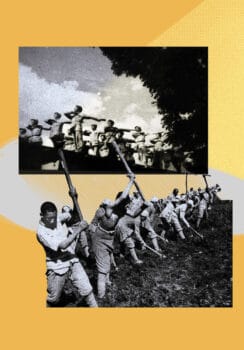
Top: Drama students engage in early morning physical training.
Bottom: An Eighth Route Army production brigade cultivates land in Nanniwan, southeast of Yan’an.
(Credit: [Yan’an Red Cloud Platform [延安红云平台 ] and an unknown source)
The Yan’an Spirit 80 Years On
After Talks was first published on 19 October 1943, the text was translated and published in dozens of languages, finding resonance with millions of people around the world.28 Inspired by the screen-printing tradition of woodcuts from Yan’an and Mao’s call for artists to be immersed in people’s struggles, the Indian artist Chittaprosad rendered heart-breaking sketches of the Bengal Famine of 1943–44, which claimed the lives of three million people at the tail-end of Britain’s brutal colonial rule.29 Cuban national poet Nicolás Guillén called Talks a ‘glittering scientific materialist platform for literature and art theories… that can help understand and determine the tasks of artists and writers amid the Cuban Revolution’.30 Indonesia’s Lekra, a cultural organisation of 200,000 members affiliated with the Communist Party of Indonesia (PKI), developed its core method of turun ke bawah, or ‘going down to the masses’, in the Yan’an spirit.31
Quotations from Chairman Mao Zedong (1966)–‘the little red book’–includes excerpts from Talks, and its penultimate chapter is dedicated to art and culture. With over one billion official editions sold in three dozen languages, the little red book made its way into the hands of countless revolutionaries as one of the most circulated books of all time, second only to the Holy Bible. In an interview with Tricontinental: Institute for Social Research, Emory Douglas, the first minister of culture of the Black Panther Party in the United States, recalled how the Party sold the little red book on street corners alongside the Party’s newspaper, each for 25 cents, carrying the message that art is a weapon in revolutionary struggle.32 The little red book was also sold in bookshops and small towns in Tanzania in Swahili and English under Julius Nyerere’s leadership. Comingled with African socialist ideas, Mao’s thinking was transmitted through the radio airwaves to reach illiterate and rural communities.33 Talks and its ideas found their own interpretations and uses in diverse places, from Mongolia to Mozambique, from Argentina to Albania, from Peru to the Philippines.
Talks is perhaps one of the most important systematisations emerging from the Third World on the role of art and culture and its theory, practice, mistakes, and lessons. It can be read as an exploration of Marxist aesthetics in the national liberation tradition, a proposal for socialist cultural policy, a manual for cadres carrying out cultural tasks, and a piece of literary theory or literature itself. Eight decades have passed since Mao gave his lectures on literature and art. Since then, China has gone from being one of the world’s poorest countries to the world’s second largest economy and a global power. So, what relevance does the Yan’an spirit hold today? In 2014, President Xi Jinping made an appeal to revive the Yan’an spirit at Talks at the Forum on Literature and Art, held in Beijing, in which he spoke about the need for writers and artists to continue Mao’s call for a socialist culture rooted in the Chinese context with an eye towards the world.34 The legacy of Talks does not belong only to China and the Chinese people, but is a product for the people of the Global South. In an interview with Tricontinental: Institute for Social research, East China Normal University Professor Lu Xinyu made a similar reflection on this legacy and revival of Mao’s Talks:
[The Yan’an Forum] called on intellectuals to serve the people, with the development of mass culture that ensured that peasants’ subjectivity was at the centre of China’s Revolution. That has been the historical target of the CPC from that time till now. Intellectuals went to the countryside to combine forces with the peasants. Now, we see huge numbers of cadres, teachers, and intellectuals go to the countryside in the rural revitalisation and poverty alleviation campaigns.35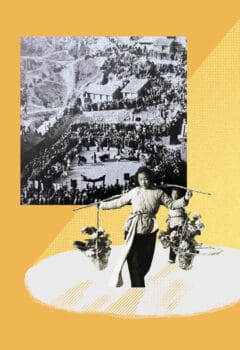
Top/Bottom: Yangge singing troupes perform for the people at the 1943 Spring Festival celebration.
(Credit: Yan’an Red Cloud Platform [延安红云平台] and China Youth Daily [中国青年报])
Beside the Yellow River, on the bank of the waters of the Yan,
is the yellow earth plateau.
Before the yaodong caves the millstone grinds,
it seems a return to yesterday.
I’m going to Yan’an,
to see the soft passing of time,
to see thousands of hills, everywhere red.– ‘I’m going to Yan’an’ (2011), song composed by Xu Peidong, written by Hua Feng, and sung by Li Long for the 90th anniversary of the Communist Party of China’s founding.
Bibliography
- CCTV 中国中央电视台, ‘Wenyi de dengta’ 文艺的灯塔 [A beacon of literature and art], 20 May 2017, tv.cctv.com
- CGTN, ‘A quick look at the epic journey of the Long March’, 1 July 2019, news.cgtn.com
- Denton, Kirk A. ‘Yan’an as a site of memory’. In Places of Memory in Modern China: History, Politics, and Identity, edited by Marc Andre Matten. Leiden: Brill, 2012.
- Ding Ling 丁玲. ‘Zuojia shi zhengzhihua le de ren’ 作家是政治化了的人 [A writer is a politicized person], Quánguó gāoděng yuàn xiào wényì lǐlùn xuéshù tǎolùn huì漫谈文艺与政治的关系 [On The Relationship Between Literature and Politics], 全国高等院校文艺理论学术讨论会 [Symposium on Art and Literature Theory in China’s Higher Education], Lushang, Jiujiang City, Jiangxi Province, August 1980.
- Ding Xiaoping 丁晓平. ‘Hu qiaomu yu ‘zai yan’an wenyi zuotanhui shang de jianghua’ 胡乔木与《在延安文艺座谈会上的讲话》[Hu Qiaomu and the Talks at the Yan’an Forum on Literature and Art]. Zhonghua dushu bao 中华读书报 [China Reading Weekly], 28 May 2012. www.tsinghua.org.cn
- Douglas, Emory. Interview by Tings Chak, 7 March 2022, transcript Tings Chak.
- Fan Xue范雪, ‘Dao shanbei qu: qiqi shibian hou yipi qingnian de rensheng xuanze’ 到陕北去:七七事变后一批青年的人生选择 [Go to Shaanbei: the life choice of a group of young people after the July 7th Incident], Baoma 保马, 16 March 2020. mp.weixin.qq.com
- Gramsci, Antonio. ‘The Intellectuals’. In Selections from the Prison Notebooks. Translated and edited by Q. Hoare and G.N. Smith, 3–23. New York: International Publishing, 1971. www.marxists.org
- Hu Qiaomu 胡乔木. Hu qiaomu huiyi mao zedong胡乔木回忆毛泽东 [Hu Qiaomu Memories of Mao Zedong]. Beijing: Ren min chu ban she人民出版社[People’s Publishing House], 2003.
- Huo Jinglian 霍静廉. ‘Qiantan mao zedong “zai yan’an wenyi zuotanhui shang de jianghua” zai guoneiwai de yingxiang’ 浅谈毛泽东《在延安文艺座谈会上的讲话》在国内外的影响 [On the domestic and international influence of Mao’s Talks at the Yan’an Forum on Literature and Art]. 纪念毛泽东同志《讲话》发表60周年研讨会[Seminar to commemorate the 60th anniversary of Comrade Mao’s Talks] (May 2002). cpfd.cnki.com.cn
- Jiang Hui 蒋晖, ‘“Zai yan’an wenyi zuotanhui shang de jianghua” zai feizhou de gushi’《在延安文艺座谈会上的讲话》在非洲的故事 [The African story of the Talks at the Yan’an Forum on Literature and Art], Baoma 保马, 30 November 2015. mp.weixin.qq.com
- Judd, Ellen R. ‘Prelude to the “Yan’an Talks”: Problems in Transforming a Literary Intelligentsia’. Modern China 11, no. 3 (July 1985): 377–408.
- Li Huanhuan. ‘On the Inheritance and Development of Yan’an Yangge during the War of Resistance’. Academic Journal of Humanities & Social Sciences 4, no. 2 (2021): 35-39.
- Lu, Xinyu. Interview by Tings Chak, 14 March 2022, transcript by Tings Chak.
- Ma Ke. ‘From “Yangko” Opera to “The White-Haired Girl”’. Peking Review, 6, no. 21 (May 1962): 20–22.
- Ma Kefung 马克锋. ‘Shu wan qingnian weihe maozhe fengzian benfu yan’an?’ 数万青年为何冒着风险奔赴延安?[Why do tens of thousands of young people take risks to go to Yan’an?]. 人民论坛 [China Forum], 25 February 2021, www.kunlunce.com
- Mao, Zedong. ‘Talks at the Yan’an Forum on Literature and Art’. In Selected Works of Mao Tse-tung. Peking: Foreign Languages Press, 1967. www.marxists.org
- Marx, Karl. Theses on Feuerbach. 1845. www.marxists.org
- McDougall, Bonnie. Mao Zedong’s ‘Talks at the Yan’an Conference on Literature and Art’: A Translation of the 1943 Text with Commenary. Ann Arbor: University of Michigan, 1980.
- Meisner, Maurice. Mao Zedong: A Political and Intellectual Portrait. Cambridge: Polity Press, 2007.
- Lal, Priya. ‘Maoism in Tanzania: Material connections and shared imaginaries’. In Mao’s Little Red Book: A Global History, edited by Alexander C. Cook, 96–116. Cambridge University Press, 2014.
- Lenin, V.I. ‘On Soviet Power’. In Lenin’s Collected Works, Vol. 29, 248–249 . Moscow: Progress Publishers, 1972. www.marxists.org
- Lenin, V.I. ‘Party Organisation and Party Literature’. In Lenin Collected Works, Vol. 10, 44–49. Moscow: Progress Publishers, 1965. www.marxists.org
- Mitter, Rana. Forgotten Ally: China’s World War II, 1937–1945. Boston/New York: Houghton Mifflin Harcourt, 2013.
- Rubin, Kyna. ‘Writers’ Discontent and Party Response in Yan’an Before “Wild Lily”: The Manchurian Writers and Zhou Yang’. Modern Chinese Literature 1, no. 1 (September 1984): 79–102.
- Snow, Edgar. Red Star Over China. New York: Grove Press, 1994.
- Soon, Simon. ‘Engineering the human soul in 1950s Indonesia and Singapore’. In Art, Global Maoism and the Chinese Cultural Revolution, edited by Jacopo Galimberti et al, 53–66. Manchester University Press, 2020.
- Sunderason, Sanjukta. ‘Framing margins: Mao and visuality in twentieth-century India’. In Art, Global Maoism and the Chinese Cultural Revolution, edited by Jacopo Galimberti et al, 67–86. Manchester University Press, 2020.
- Tricontinental: Institute for Social Research, Serve the People: The Eradication of Extreme Poverty in China. Studies in Socialist Construction no. 1, July 2021. thetricontinental.org
- Tricontinental: Institute for Social Research, The Legacy of Lekra: Organising Revolutionary Culture in Indonesia. Dossier no. 35, December 2020. thetricontinental.org
- Tricontinental: Institute for Social Research, The New Intellectual. Dossier no. 13, February 2019. thetricontinental.org
- Wang Xiaoping. Contending for the ‘Chinese Modern’: The Writing of Fiction in the Great Transformative Epoch of Modern China, 1937-1949. Leiden: Brill, 2019.
- Xi Jinping. ‘Speech at the Forum on Literature and Art’. Transcript of the speech in Beijing, 15 October 2014.chinacopyrightandmedia.wordpress.com
Endnotes:
- ↩ Hu Qiaomu胡乔木, Hu qiaomu huiyi mao zedong 胡乔木回忆毛泽东 [Hu Qiaomu Memories of Mao Zedong] (Beijing: People’s Publishing House, 2003), 251–268.
- ↩ Mao, Zedong. ‘Talks at the Yan’an Forum on Literature and Art’, in Selected Works of Mao Tse-tung. (Peking: Foreign Languages Press, 1967), www.marxists.org
- ↩ Fan Xue范雪, ‘Dao shanbei qu: qiqi shibian hou yipi qingnian de rensheng xuanze’ 到陕北去:七七事变后一批青年的人生选择 [Go to Shaanbei: the life choice of a group of young people after the July 7th Incident], Baoma 保马, 16 March 2020, mp.weixin.qq.com
- ↩ Rana Mitter, Forgotten Ally: China’s World War II, 1937–1945 (Boston/New York: Houghton Mifflin Harcourt, 2013).
- ↩ Fan Xue 范雪, ‘Dao shanbei qu: qiqi shibian hou yipi qingnian de rensheng xuanze’ 到陕北去:七七事变后一批青年的人生选择 [Go to Shaanbei: the life choice of a group of young people after the 7 July Incident].
- ↩ Kirk A. Denton, ‘Yan’an as a site of memory’, in Places of Memory in Modern China: History, Politics, and Identity, ed. Marc Andre Matten (Leiden: Brill, 2012), 239.
- ↩ Maurice Meisner, Mao Zedong: A Political and Intellectual Portrait (Cambridge: Polity Press, 2007), 75.
- ↩ Meisner, Mao Zedong, 74; ‘A quick look at the epic journey of the Long March’, CGTN, 1 July 2019, news.cgtn.com
- ↩ Edgar Snow, Red Star Over China (New York: Grove Press, 1994), 190.
- ↩ Meisner, Mao Zedong, 75–76.
- ↩ Ma Kefung 马克锋. ‘Shu wan qingnian weihe maozhe fengzian benfu yan’an?’ 数万青年为何冒着风险奔赴延安?[Why do tens of thousands of young people take risks to go to Yan’an?]. 人民论坛 [China Forum], 25 February 2021, www.kunlunce.com
- ↩ Ellen R. Judd, ‘Prelude to the “Yan’an Talks”: Problems in Transforming a Literary Intelligentsia’, Modern China 11, no. 3 (July 1985): 377–408.
- ↩ Snow, Red Star Over China, 115–116.
- ↩ Ding Xiaoping丁晓平. ‘Hu qiaomu yu ‘zai yan’an wenyi zuotanhui shang de jianghua’ 胡乔木与《在延安文艺座谈会上的讲话》 [Hu Qiaomu and the Talks at the Yan’an Forum on Literature and Art]. 中华读书报 [China Reading Weekly], 28 May 2012, www.tsinghua.org.cn
- ↩ Kyna Rubin, ‘Writers’ Discontent and Party Response in Yan’an Before “Wild Lily”: The Manchurian Writers and Zhou Yang’, Modern Chinese Literature 1, no. 1 (September 1984): 79–102; Judd, ‘Prelude to the “Yan’an Talks”’, 377–408.
- ↩ Rubin, ‘Writers’ Discontent and Party Response’, 90.
- ↩ V. I. Lenin, ‘Party Organisation and Party Literature’, in Lenin Collected Works, Vol. 10 (Moscow: Progress Publishers, 1965), 44–49, www.marxists.org
- ↩ Judd, ‘Prelude to the “Yan’an Talks”’, 377–408.
- ↩ Karl Marx, Theses on Feuerbach, 1845, www.marxists.org; Antonio Gramsci, ‘The Intellectuals’, in Selections from the Prison Notebooks, trans. and ed. Q. Hoare and G.N. Smith (New York: International Publishing), 3–23, www.marxists.org; Tricontinental: Institute for Social Research, The New Intellectual, Dossier no. 12, February 2019, thetricontinental.org
- ↩ V.I. Lenin, ‘On Soviet Power’, in Lenin Collected Works, Vol. 29, (Moscow: Progress Publishers, 1972), 248–249, www.marxists.org
- ↩ Ma Ke (spelled ‘Ma Ko’ in original publication), ‘From “Yangko” Opera to “The White-Haired Girl”’, in Peking Review 6, no. 21 (25 May 1962): 20–22.
- ↩ Hu Qiaomu, Hu qiaomu huiyi mao zedong 胡乔木回忆毛泽东 [Hu Qiaomu Memories of Mao Zedong], 251–268.
- ↩ Ma Ke, ‘From “Yangko” Opera to “The White-Haired Girl”’, 20–22.
- ↩ Ibid.
- ↩ Li Huanhuan, ‘On the Inheritance and Development of Yan’an Yangge during the War of Resistance’, in Academic Journal of Humanities & Social Sciences 4, no. 2 (2021): 35–39.
- ↩ Wang Xiaoping, Contending for the ‘Chinese Modern’: The Writing of Fiction in the Great Transformative Epoch of Modern China, 1937–1949 (Leiden: Brill, 2019), 575.
- ↩ Ding Ling, 作家是政治化了的人 [A writer is a politicised person], 全国高等院校文艺理论学术讨论会 [Symposium on Art and Literature Theory in China’s Higher Education], Lushang, Jiujiang City, Jiangxi Province, August 1980.
- ↩ Bonnie McDougall, Mao Zedong’s ‘Talks at the Yan’na Conference on Literature and Art’: A Translation of the 1953 Text with Commentary (Ann Arbor: University of Michigan, 1980).
- ↩ Sanjukta Sunderason, ‘Framing margins: Mao and visuality in twentieth-century India’, in Art, Global Maoism and the Chinese Cultural Revolution, ed. Jacopo Galimberti et al (Manchester University Press, 2020), 72–73.
- ↩ Huo Jinglian 霍静廉. ‘Qiantan mao zedong “zai yan’an wenyi zuotanhui shang de jianghua” zai guoneiwai de yingxiang’ 浅谈毛泽东《在延安文艺座谈会上的讲话》在国内外的影响 [On the domestic and international influence of Mao’s Talks at the Yan’an Forum on Literature and Art]. 纪念毛泽东同志《讲话》发表60周年研讨会[Seminar to commemorate the 60th anniversary of Comrade Mao’s Talks] (May 2002). cpfd.cnki.com.cn
- ↩ Tricontinental: Institute for Social Research, The Legacy of Lekra: Organising Revolutionary Culture in Indonesia, Dossier no. 35, December 2020, thetricontinental.org; Simon Soon, ‘Engineering the human soul in 1950s Indonesia and Singapore’, in Art, Global Maoism and the Chinese Cultural Revolution, ed. Jacopo Galimberti et al. (Manchester University Press, 2020), 53–66.
- ↩ Emory Douglas, interview by Tings Chak, 7 March 2022, transcript Tings Chak.
- ↩ Priya Lal, ‘Maoism in Tanzania: Material connections and shared imaginaries’, in Mao’s Little Red Book: A Global History, ed. Alexander C. Cook (Cambridge University Press, 2014), 97–101.
- ↩ Xi Jinping, ‘Speech at the Forum for Literature and Art’, Transcript of the speech in Beijing, 15 October 2015, chinacopyrightandmedia.wordpress.com
- ↩ Lu Xinyu, interview by Tings Chak, 14 March 2022, transcript by Tings Chak.
- ↩ Tricontinental: Institute for Social Research, Serve the People: The Eradication of Extreme Poverty in China, Studies in Socialist Construction no. 1, July 2021, thetricontinental.org
- ↩ Lu Xinyu, interview by Tings Chak.

